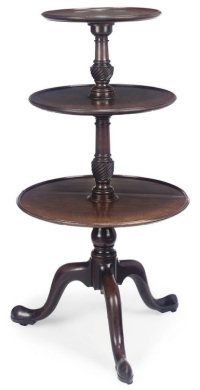Lazy Susan
Q From Toby Blyth, Australia: I’ve come across an article in the Los Angeles Times, dated 25 March, which describes the origin of the term lazy Susan as a domestic mystery. Do you agree?
A It’s fair. This name for a revolving tray on a table for holding condiments and the like has become known throughout the English-speaking world in the past century. But nobody knows who named it or who Susan might have been.
The usual sources point to an advertisement in Vanity Fair in 1917 as the first known record of the term lazy Susan. I have found earlier examples, which also illustrate the social milieu in which the term — and the device — began to be fashionable in the early years of that decade. One article appeared under the odd headline “Giving an Automatic Dinner”:
The other day a charming and capable woman gave a formal dinner to a party of eight guests without any help of servants. A superficial glance at the automatic dinner-table reveals nothing extraordinary. One is pleasantly aware of the sparkle of silver and glass, the hospitable glow of lamplight, the rich shine of mahogany. There is a beautiful lace centerpiece around which covers are laid in the usual way. Knives and forks and the service plate, napkins and glasses are where one expects to find them. Even the raised silver disk in the center surmounted by a vase of delicate clematis stars might be intended solely for decoration. But this raised silver disk is precisely the borderland between the old fashion and the new. It is the turn-table or “Lazy Susan,” the characteristic feature of the self-serving dinner table.
Christian Science Monitor, 25 Sep 1912.
The household here is clearly well-off and able to afford servants, but the hostess has either chosen to dispense with them, or perhaps been unable to recruit them. Within a year, the fashion had spread some way west:
Mrs. Curtis has inaugurated ... the “Lazy Susan” method of serving, which has solved most beautifully the problem of service without an extra maid.
Lima Daily News (Ohio), 31 Dec 1913.
This is currently the first known reference to the device:
John B. Laurie, as the resuscitator of “Lazy Susan,” seems destined to leap into fortune as an individual worker. “Lazy Susan” is a step toward solving the ever-vexing servant problem. She can be seen, but not heard, nor can she hear, she simply minds her business and carries out your orders in a jiffy.
Boston Journal, 8 Nov 1903. Mr Laurie was a carpenter, who made a lazy Susan at the request of a lady. Thanks to Barry Popik for finding this.

A rather fine three-tier mahogany dumbwaiter of the third quarter of the eighteenth century
There are various misconceptions about the origin of the device. It is much older than the name lazy Susan, examples being known from the early eighteenth century in the UK. It was then called a dumb-waiter, for good reason:
Tom Waitwell, a Footman, complains, that he and his Brotherhood have had the Honour to wait on the Quality at Table; by which King of Service they became Wits, Beaus, and Politicians, adopted their Masters Jokes, copied their Manners, and knew all the Scandal of the Beau-Monde; but are now supplanted by a certain stupid Utensil call’d a Dumb Waiter, which answers all Purposes as well, except making Remarks, and Telling of Tales, and this for this very Reason they are preferr’d.
The Gentleman’s Magazine, Apr. 1732; reprinted from the Weekly Register, 15 Apr. 1732. It was a century later, around the 1840s, that the term was transferred in the US to a little lift for moving food between floors.
Some stories attach the invention of the dumb-waiter to Thomas Jefferson; dating makes this impossible, since he was born only in 1743; however, he came across them while in Paris and introduced them to his residences in the US, so he became associated with them. The term lazy Susan is sometimes said to be an opprobrious epithet applied to Susan B Anthony, an early campaigner for gender equality, but there’s no evidence for this. The Oneida community, a utopian commune in New York State, is known to have used (or possibly reinvented) the device sometime in the latter part of the nineteenth century, but despite claims to the contrary there’s no record of their using the term lazy Susan for it. A plausible suggestion is that Susan was a generic term for a servant and that her name was humorously transferred to the tray.
All in all, calling it a domestic mystery is pretty much correct.
